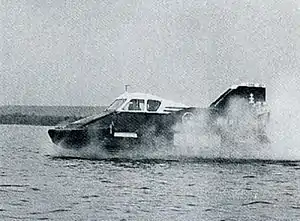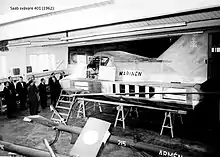 Saab 401 MEFA | |
| Class overview | |
|---|---|
| Name | Saab 401 Mefa |
| Builders | Saab AB, Karlskronavarvet (Saab Kockums), Vickers-Armstrongs |
| Operators | Swedish navy |
| In service | 1963–1964 |
| Completed | 1 |
| Preserved | 1 |
| General characteristics | |
| Type | Hovercraft |
| Tonnage | 1.63 tonnes[1] |
| Length | 7.3 m (24 ft)[1] |
| Beam | 3.1 m (10 ft)[1] |
| Height | 2.05 m (6 ft 9 in) (on landing pads) |
| Installed power | 180 shp (130 kW) |
| Propulsion | Lycoming 4 cylinder 4-stroke 180 hp; McCulloch 4 cyl. 2-stroke engine for propulsion engines (later added), 72hp |
| Speed | 40 knots (74 km/h)[1] |
The Saab 401 MEFA was an experimental air-cushioned vehicle with a weight of 2 tons and capable of about 40 knots on open water with two people on board. A single prototype was built under contract to the Swedish Navy. The craft was first tested in 1963. The Navy retired the project in 1967 when it donated the 401 prototype to the Maritime Museum in Karlskrona Sweden.
History
The Saab 401 MEFA project was created in the late 1950s as a collaboration between Saab and the Royal Swedish Naval Materiel Administration,[2] Karlskronavarvet (Saab Kockums) and the Swedish National Aeronautical Research Institute (FFA). Later the project was continued on lean funds at FFA.[3][4][5][6] MEFA is the Swedish acronym for Markeffektfarkost (ground effect vehicle); the craft was also known as the "MEFAN".[7]
Its design was led by Olof Ljungström.[7] Vickers-Armstrongs was contracted for engineering work.[8]
It was first tested March 4, 1963, in Norrköping.[9][10] In January 1964, the 401 prototype was delivered to the Berga Naval Base for testing.[7] The craft was retired by the Navy in 1967, and donated to the Karlskrona maritime museum.[7][11]
Design
The vehicle's lift was created by an eight-blade fan, driven by a 180 hp Lycoming O-360 piston engine.[12][13][14] Propulsion was achieved partly with adjustable drive ports in the air chamber, and also by two 72 hp motors driving external propellers.[15] Its hovering height was maximum 17 cm.[16]
The Saab 401 was not equipped with the large rubber-skirts used to direct airflow that are typical in hovercraft.[7] Instead, the vehicle was designed so that it could withstand direct contact with the lake and solid surfaces such as ice.[7]

References
- 1 2 3 4 Hall, Kenneth (9 January 1964). "Hovercraft today and tomorrow". New Scientist. Vol. 21, no. 373. Harrison, Raison and Co. p. 78.
- ↑ Transport World. Vol. 128. "Transport World" Publishing Company. 1963.
- ↑ Uppslagsboken: Svävarfarkost: tekn. beskr. o data, typskisser, pressmeddelanden etc. betr Saab 401 A & B.
- ↑ Modellflygnytt Nr 5 årgång 1963
- ↑ Tidskriften Verkstäderna Årgång 1964
- ↑ Blekinge läns tidning 2017-12-16- Unik farkost bortglömd i förråd
- 1 2 3 4 5 6 Mellgren, Erik. "Saabs svävare fick framgång i liten skala" (PDF). iva.se.
- ↑ "Hovercraft Agreement with Saab". Fairplay Shipping Journal. Vol. 206, no. 4142. Fairplay Publications Limited. 10 January 1963.
- ↑ Olson, Björn (1987). The Saab-Scania story. Streiffert. ISBN 978-91-7886-014-2.
- ↑ Indian Aviation. April 1963.
- ↑ "Svävare". digitaltmuseum.se.
- ↑ Mechanical Engineering: The Journal of the American Society of Mechanical Engineers. The Society. 1962.
- ↑ Jane's Surface Skimmers. Sampson Low, Marston. 1967.
- ↑ Jane, Frederick Thomas (1965). Jane's All the World's Aircraft. Sampson Low, Marston & Company.
- ↑ McLeavy, Roy (1968). Jane's Surface Skimmer Systems. S. Low, Marston.
- ↑ Standard. 1963.